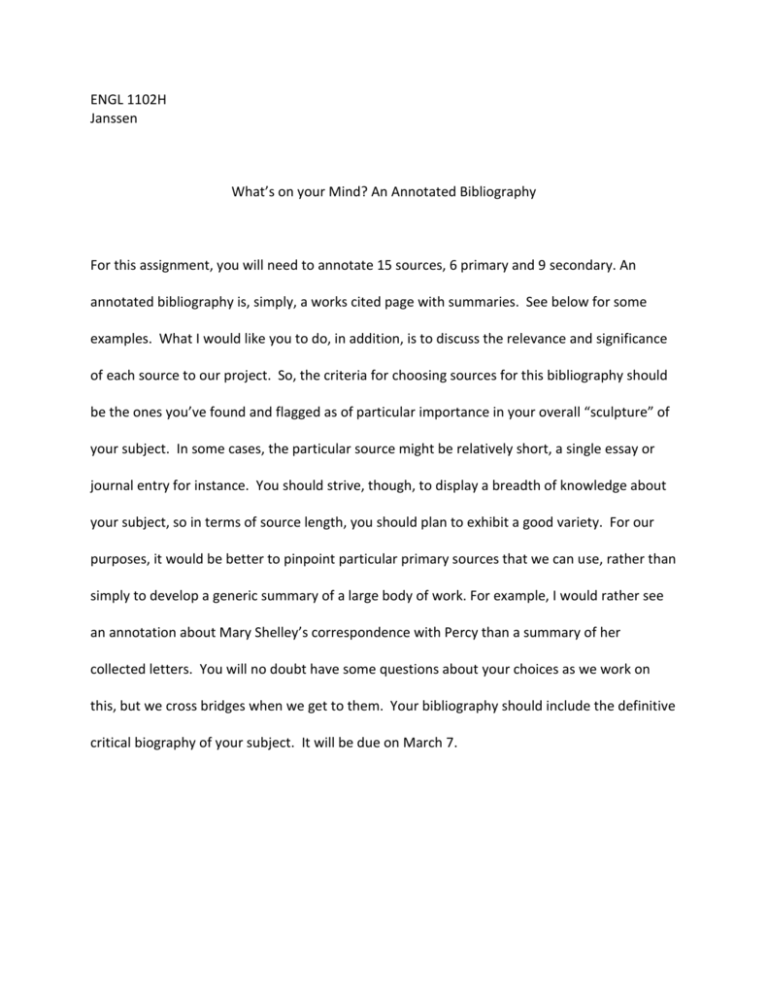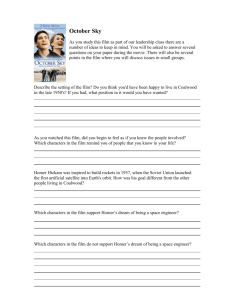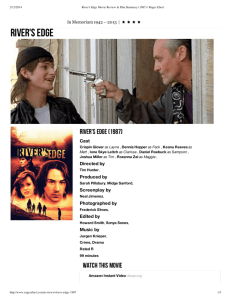ENGL 1102H Janssen What's on your Mind? An Annotated
advertisement

ENGL 1102H Janssen What’s on your Mind? An Annotated Bibliography For this assignment, you will need to annotate 15 sources, 6 primary and 9 secondary. An annotated bibliography is, simply, a works cited page with summaries. See below for some examples. What I would like you to do, in addition, is to discuss the relevance and significance of each source to our project. So, the criteria for choosing sources for this bibliography should be the ones you’ve found and flagged as of particular importance in your overall “sculpture” of your subject. In some cases, the particular source might be relatively short, a single essay or journal entry for instance. You should strive, though, to display a breadth of knowledge about your subject, so in terms of source length, you should plan to exhibit a good variety. For our purposes, it would be better to pinpoint particular primary sources that we can use, rather than simply to develop a generic summary of a large body of work. For example, I would rather see an annotation about Mary Shelley’s correspondence with Percy than a summary of her collected letters. You will no doubt have some questions about your choices as we work on this, but we cross bridges when we get to them. Your bibliography should include the definitive critical biography of your subject. It will be due on March 7. Annotated Bibliography Samples Sample 1 Wofford, Susanne L. “A Critical History of Hamlet.” Hamlet. Ed. Susanne L. Wofford. New York: Bedford / St. Martin’s, 1994. 181-207. Wofford surveys the critical attention Hamlet has received beginning with Shakespeare’s cultural status during his own time. Wofford’s main focus, however, lies in the critical attention given to Hamlet in the nineteenth and twentieth centuries. In particular, she focuses on the Romantic Hamlet of the nineteenth century, as developed by writers such as Samuel Taylor Coleridge. She also emphasizes the importance of both A.C. Bradley’s and Sigmund Freud’s interpretations of Shakespeare’s most famous character, especially focusing on Freud’s use of the play in developing his theory of the Oedipus complex. She also touches on other important readers of the play in the twentieth century, such as T.S Eliot, G. Wilson Knight, and John Dover Wilson. She concludes by pointing toward some present-day developments in the study of the play and asserts that “Hamlet will continue to puzzle and possess the minds of future generations, who can make the play their own only by in turn taking critical possession of it” (205). With its summary of the high points in Hamlet criticism, this essay is a useful starting point for those beginning research on the play. Janssen ENGL 1102 Sample 2 Gilbert, Sandra M. “Plain Jane’s Progress.” Jane Eyre. Beth Newman, ed. Boston: Bedford/St. Martin’s Press, 1996. 475-501. As her title implies, Gilbert traces Jane’s character development and journey by focusing upon her “progress,” in the tradition of John Bunyan’s Pilgrim’s Progress. She emphasizes that the goal of Jane’s progress is to reach a sense of maturity and independence in the world. As is characteristic of a “progress,” Gilbert stresses the symbolic nature of important places and people as Jane struggles to reach that goal. She argues that Jane’s central struggle throughout the novel is to overcome and lay to rest the “wicked” orphan child who was imprisoned in the Red Room in the early chapters. Accordingly, Gilbert sees Bertha Mason as Jane’s doppelganger, and Bertha’s fate is viewed as a possible conclusion for Jane herself were she to fail in her progress toward independence. Gilbert ends with the suggestion that Ferndean is a fitting and satisfying conclusion for Jane and Rochester, even though that conclusion does not solve the problems of patriarchy that the novel poses. Here are a couple sample annotations of electronic sources. Sample 3 Wall, James M. “Sullivan Travels Again.” Christian Century. 118 (2001). Academic Search Premier. EBSCOhost. Gordon College, Hightower Lib. 5 Dec. 2003 <http://www.galileo.usg.edu>. James M. Wall describes Preston Sturges’ films as having an innocent spirit and the ability to recall a time when people had reason to anticipate the best possible outcome about the natural goodness of the human spirit, while in the midst of the cynical realism of the post war era for which his style did not survive. He stated that it was not until Joel and Ethan Coen’s film O Brother Where Art Thou? that Sturges resurfaced from film history. Due to the Academy Awards press office informing him that the screenplay for O Brother Where Art Thou? was nominated as an adapted rather than an original screenplay because it took inspiration from Homer’s Odyssey, he decided to check out the original to see if there might be more Sturges than Homer in the film. James M. Wall states that the Coens lifted their title from Sullivan’s Travels and maintained Sturges’ style, mixing comedy with an innocence bordering on sentimentality. He continues by describing various aspects of both films, such as the music, characters and the humorous take on the brutal penal system.. He is descriptive in his account of the world’s events and emotional state at the birth of Sullivan’s Travels. He continues by recounting lines and scenes from Sullivan’s Travels and ends by stating that it would be a fitting tribute if the Oscar for Best Adapted Screenplay is awarded to the Coens for their upbeat homage to Sturges. Sample 4 Ebert, Roger. “O Brother, Where Art Thou?” Chicago Sun-Times. 29 Dec. 2000. 27 April 2004. http://www.suntimes.com/ebert/ebert_reviews/2000/12/122901.html Ebert begins his review by noting that the film is an adaptation of Homer’s The Odyssey. He also curiously mentions that the Coen Brothers claim to have never read Homer’s epic poem. Ebert focuses on the setting of the film, explaining that it takes place during Depression-era Mississippi. Along with The Odyssey, Ebert also reveals the film’s other source, Preston Sturges’ Sullivan’s Travels, from which the film gets its title. Ebert feels that all these different elements don’t cohere in the film overall. He does concede, though, that in some ways The Odyssey is also not a unified whole; at one point, he refers to Homer’s epic as a “road movie.” Although he appreciated particular scenes in the film, such as the Klan rally and the episode with the Sirens, he ultimately gives the film a lukewarm review (2.5 stars) because, in his view, the film fails to tie together all of its various strands. Documenting Your Research Inevitably, problems and questions will arise as you begin the work of documenting the sources you intend to use in your essay. One indispensable resource for such questions is the section on MLA documentation on pages 374-419 in the Gordon College Reference Guide. Of course, you can always ask me as well, but remember that the general idea is to create a paper trail. You need to provide enough information so that I can find all the sources you used. Internet and other electronic sources can be especially tricky, and since all of you will be using some esources, I have provided some examples below. Here is how to cite a source from Galileo: Wall, James M. “Sullivan Travels Again.” Christian Century. 118 (2001). Academic Search Complete. EBSCOhost. Gordon College, Hightower Lib. 5 Dec. 2003 <http://www.galileo.usg.edu>. *Note that the second date in the above entry (5 Dec. 2003) is the date the source was accessed. The same is true for the second date (27 April 2004) below. Here is a citation from an online newspaper: Ebert, Roger. “O Brother, Where Art Thou?” Chicago Sun-Times. 29 Dec. 2000. 27 April 2004. http://www.suntimes.com/ebert/ebert_reviews/2000/12/122901.html Here is how to cite a reference work: “Nice.” The Oxford English Dictionary. 2nd ed. CD-ROM. Oxford: Oxford UP, 1992. *You don’t need an access date for the OED.




